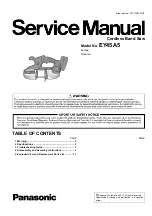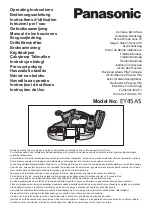
FRANÇAIS
ENGLISH
ENGLISH
FRANÇAIS
FRANÇAIS
ENGLISH
ENGLISH
FRANÇAIS
v.081126
21. ENSURE THE EXTENSION CORD YOU USE IS OF SUFFICIENT GAUGE
FOR ITS LENGTH.
RECOMMENDED MINIMUM WIRE GAUGE FOR EXTENSION CORDS
Amps
from Tool
Nameplate
7.62 m
(25’)
long
15.24 m
(50’)
long
22.86 m
(75’)
long
30.48 m
(100’)
long
45.72 m
(150’)
long
60.96 m
(200’)
long
0 - 5 amps
16 ga.
16 ga.
16 ga.
14 ga.
12 ga.
12 ga.
5.1 - 8 amps
16 ga.
16 ga.
14 ga.
12 ga.
10 ga.
Do Not
Use
8.1 - 12
amps
14 ga.
14 ga.
12 ga.
10 ga.
Do Not
Use
Do Not
Use
12.1 - 15
amps
12 ga.
12 ga.
10 ga.
10 ga.
Do Not
Use
Do Not
Use
15.1 - 20
amps
10 ga.
10 ga.
10 ga.
Do Not
Use
Do Not
Use
Do Not
Use
If an extension cord is required, it must be of the proper size and type to
supply the correct current to the tool without heating up. Otherwise, the
extension cord could melt and catch fire, or cause electrical damage to the
tool.
22. DO NOT ABUSE THE CORD.
Never carry your tool by the cord or pull on the
cord to unplug it. Protect the cord from potential sources of damage: heat, oil &
solvents, sharp edges, or moving parts. Replace damaged cords immediately.
23. GROUNDED TOOLS
must be plugged into an outlet that itself is properly
installed and grounded. Grounding provides a low-resistance path to
carry electricity to the ground and away from the operator, should the tool
malfunction electrically. Do not remove the grounding prong from the plug
or alter the plug in any way. If in doubt as to whether the outlet is properly
grounded according to code, check with a qualified electrician.
24. DO NOT USE THE TOOL IF IT CANNOT BE SWITCHED ON OR OFF.
Have
your tool repaired before using it.
25. DISCONNNECT THE PLUG FROM POWER BEFORE MAKING ANY
ADJUSTMENTS.
Changing attachments or accessories can be dangerous if
the tool could accidentally start.
26. SERVICE AND REPAIRS
should be made by qualified repair technicians at an
authorized repair centre. Improperly repaired tools could cause serious shock
or injury.
1. Do not dry cut with blades or cutting wheels designed for wet cuts.
2. Make sure you use the correct blade for the job you are doing. Use only
smooth-edge blades, free of openings, grooves, and teeth.
3. Ensure there is a continuous flow of water on both sides of the blade during
operation.
4. Check diamond blades carefully for cracks, nicks, and missing diamond
matrix or mis-alignment. Replace damaged blade before operating.
WARNING:
DO NOT USE DAMAGED BLADES. They may cause bodily harm.
POSITIONING OF THE TILE SAW
A.
To avoid the possibility of the appliance plug or receptacle getting wet,
position the tile saw to one side of a wall mounted receptacle to prevent
water from dripping onto the receptacle or the plug. The user should arrange
a “drip loop” in the cord connecting the saw to a receptacle. The “drip loop” is
that part of the cord that is below the level of the receptacle, or connector if
an extension cord is used. This is done to prevent water from travelling along
the cord and being exposed to the power source.
B.
If the plug or receptacle does get wet,
DO NOT
unplug the cord. Disconnect
the fuse or circuit breaker that supplies the power to the tool. Then, unplug
and check for a presence of water in the receptacle.
IMPORTANT SAFETY INSTRUCTIONS
SAFETY INSTRUCTIONS SPECIFIC TO THE TILE SAW
Содержание STS10
Страница 22: ...ENGLISH FRAN AIS 22 SCHEMATIC DRAWING SCH MA...




































